An Intelligent Conversation About Health and Investing In a COVID-19 World
We’re going to try something a bit different today. In a bid to learn more about Covid-19 and what it means for our day-to-day lives, as well as our investment portfolios, I’ve read a TON of stuff. (All of the folks who are taking care of children during this quarantine are cursing me right now.) Some of the writing was pretty good, much of it was standard boilerplate predictions done to fill space.
John Robertson (PhD) is a guy who has been on the internet since I was in grade school, and who has been writing insightful takes on life and personal finance for the last two decades. He is a much better thinker and writer than he is self-promoter – and this is why you might not be aware of just how awesome he is. When John writes something new, or has something to say, I generally shut up and take notice no matter what the topic. However, when it comes to Covid-19 – and specifically, the intersection of the pandemic with investment – I don’t know many people who are even close to as qualified to talk about this stuff.
Check out John’s article from March 19th for more details on why I think the guy knows what the heck he is talking about!
John isn’t a medical doctor, but his MSc and PhD are in Medical Biophysics. When he’s not writing excellent Canadian personal finance material, John fills a variety of roles for the Techna Institute, where he interacts with healthcare experts on many different projects.
On the money side of the equation, John has not only written an excellent book on investing for Canadians (that I 100% agree with), but he has even put together an entire course on the subject matter! I’m not saying that John is the only fellow out there talking about index investing – but he is one of the few people that actually explains how to do it on your own in a way anyone can understand. And it’s comprehensive, including all the bits that can throw new investors for a loop (like what to do with the tax slip you get in March) so you won’t have to worry that you forgot to search for an important piece of information when you’re just wrapping your head around the topic in the first place.
Beyond his bonafides in both the world of health/science and finance, I find John to be the embodiment of the recent book I’m reading called: Range: Why Generalists Triumph in a Specialized World. In other words, if you head over to John’s blog, in between his thoughts on quantifying the cost-benefit of specific cancer treatments, and TFSA vs RRSP articles, you’ll see a treatise on why we should wear headgear when we go curling. It’s because of his widespread thirst for information and curious nature that I started bugging John to write more about our recent world.
Well… bugging is putting it lightly. I’ve been harrassing John to write more, because I’m sick of reading stuff that either re-hashes the few original insights out there, or the boatload of drivel that is widely available! After badgering him with specific questions on social media, I had a brainwave: Why not take advantage of John’s good nature and simply impose upon him to not only answer questions for me, but for all of our readers as well!
Below you’ll see John and I go back and forth a few times (complete with some excellent graph work from John) and we sort of alternate between Q/A, and then just casual conversation.
Anything from John will be formatted like this.
Without further ado… here’s an informative email exchange interview with John Robertson:
Hey John, thanks for doing this!
No problem. Like many people, I have thoughts. I also have a blog, but I’ve been terrible about updating it. I find I’m extra scatterbrained lately, and it’s hard to organize a blog post, so in a way you’re doing me a favour by thinking up the questions and sorting out my rambling answers later.
I should stress that I’m not an expert in any of these fields — my PhD is not in epidemiology, and I’m not involved with anyone who is an expert. I’m likely just reading much of the same information the rest of you are.
1) I guess we’ll start with some medical stuff here first, and then flow into some less important (but still pretty important) money stuff later. In your opinion – and we’re not going to hold you to a specific model here – but best guess, where do you think we’re at medically at this point in time as far as understanding the fatality rates for different groups of people, and developing various types of treatments for slowing this thing down?
Answer: We know more than we did a month ago, but we still don’t have any of the numbers dialed in precisely. There’s uncertainty with each one — the ‘error bars’ we’d call them, if you imagine putting a point on a graph, and then showing that that value could fall within some range.

For the fatality rate, we still don’t know for sure what the denominator should be — if there are a lot of people who never even really knew they had SARS-CoV-2 (the virus), then the deaths we’re seeing from Covid-19 (the disease) might not be as bad as it seems. At this point though we can say with a lot of certainty that this is worse than the flu, and there are reasons to take it seriously.
How many people will die also depends on our response — part of the reason we want to flatten the curve. If you get a severe case and have a high-functioning hospital there to take care of you, you have a much better chance of surviving than if you get it and all the intensive care unit (ICU) beds are full and the healthcare workers are burned out. Maybe it’s 2X worse, maybe 6X worse, but being able to get health care is pretty clearly important at this point.
There are a number of treatments being looked at right now. Unfortunately it’s too early to say for sure if they’re going to work (or whether any side effects will be tolerable trade-offs) — but the clinical trials are happening, and everyone including the manufacturers and regulators look to be getting ready to rapidly roll out any treatment that can work. Here’s a recent Scientific American article that has a good summary of some treatments:
You’ll notice those are all drugs for other diseases — it would take a long time to develop an all-new drug specifically for Covid-19.
And better understanding our treatment options is also why we’ve gone into lockdown to slow things down and flatten the curve. It would be amazing if we found a drug (or two or three options) that work to improve the outcomes of this disease, but even fast-tracked clinical trials take some time.
2) My personal hypothesis is that while many experts cite 12-18 months as the realistic timeline for a vaccine, I’d be shocked to see it take longer than 12 months, and not surprised at all, if we have some small semi-experimental batches ready for medical personnel 9 months from today.
My reasoning is simply that the streamlining of regulatory processes and the financial/fame motives (as well as the altruistic motivation that underlies all medical research) are completely unprecedented. In other words – I look at finding the vaccine through the eyes of an amateur economist. Am I completely off base?
Answer: Again, I’m not an expert in the field, but I’m more wishy-washy.
A huge, unprecedented effort has been put towards finding and manufacturing a vaccine. Bill Gates will help fund the start of production on seven vaccine candidates so that when the results of testing come back and we know which (if any) of the vaccine candidates works, it will be ready to roll, which will greatly cut back on the time to get it out (and I have to say it’s an expensive investment and very smart and strategic and I’m currently having trouble processing the emotions of so much admiration for the guy who we photoshopped as Locutus in the 90’s). And that’s combined with the efforts of numerous labs around the world to develop those vaccine candidates.
There are good reasons to think that with all the focus and effort and resources and urgency that a vaccine for SARS-CoV-2 will be available much sooner than for any other disease in history.
But, there is an element of luck involved. Biology isn’t engineering — it’s not just a matter of throwing enough brains and dollars at a problem and getting a solution. We don’t know for sure that a vaccine is possible — hence all the “candidates”. Different ways of creating potential vaccines will be tried, each of which will have to be tested before being rolled out. There are lots of ways for it to go wrong, from just not working (i.e. not helping those who get the vaccine to become immune to the virus) to causing allergic reactions or other side effects.
And unfortunately, the long incubation time of SARS-CoV-2 means that those clinical trials will likely take a little while, even fast-tracked as much as possible.
Though with that element of luck, we could get lucky. Some vaccine candidates are already on to the first phases of human trials. If they’re the ones that are going to work, then I think (and again, not an expert) that those end of 2020 timelines could be possible. There’s hope, but I would put my chips on the 2021 square as more likely.“
3) You were the first guy that I knew personally that was not only advocating to “Shut. It. Down.” (via excellent Facebook meme). But also to “increase capacity”. To put it in terms of the one graph everyone now pretends to understand: Not just “flatten the curve” but also to “raise the line”. (Or – as I tried to popularize – “raise the roof”.)
Governments everywhere around the world are now faced with the unenviable task of trying to balance the overloading of their healthcare systems (and the subsequent increase in overall fatality rate) with the incredible economic damage and mental trauma associated with “shutting it all down”.
So… How are we doing with flattening the curve and raising the roof?
Answer: That depends on the “we” :)
Unfortunately, the American response has been highly disjointed. They left many decisions up to state and local authorities, some of which responded quickly (though with non-compliance), while others somehow didn’t listen to, believe, or understand the evidence. Despite their best efforts, they are seeing some cities get overwhelmed.
I’ve been fairly impressed with Canada. Our leaders (even Doug Ford) are listening to the experts, they’re not playing politics. While I was hoping we’d shut the borders and do test-and-trace earlier, that ship sailed and we went into social distancing when there were only a handful of identified cases — which is what we needed to do with this that spreads so easily and takes so long to make people sick.
We look to have flattened the curve, and while there have been some bad outbreaks in long-term care, and cases are still growing (but much slower), I’m not aware of any of our major hospitals being over-run, and I don’t think that’s projected to happen in the near future with the social distance measures.
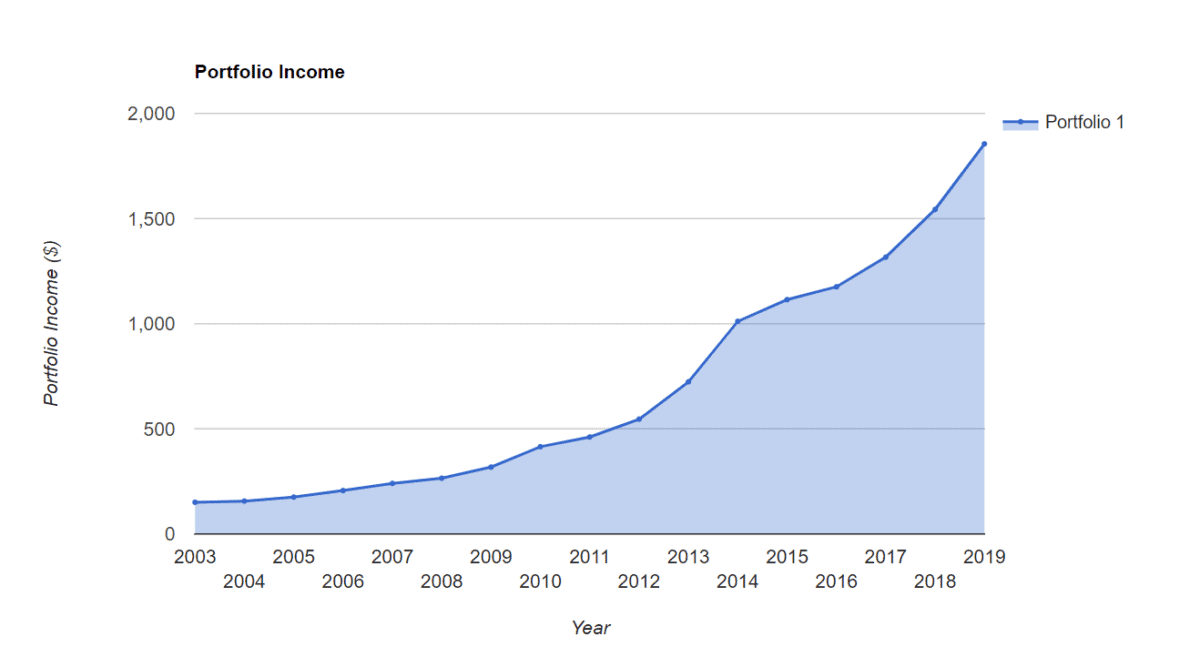
Ben Rabidoux has graphed some of the data recently: https://twitter.com/BenRabidoux/status/1249380018221920260
One disappointing element is that our testing capacity is still lagging. If you just go to the Google summary of the data, the death rate appears to be 5% for Canada — which suggests we’re either getting hit really hard despite our healthcare system still functioning, or we’re missing a lot of cases for that denominator (or it’s another issue, like that we’re having outbreaks in elder care facilities). I know that lots of people have been working really hard on that front. It would be nice to snap our fingers and be able to match South Korea’s testing capacity, but it takes time and resources, and people are mobilized now.
In terms of raising the line (or raising the roof), there’s some progress. In my blog post I was thinking we should prepare for a worst-case scenario — start setting up tent hospitals (or appropriate some pre-con condos, whatever), train a large number of people to step into health care roles if needed, etc.
We haven’t gone to that kind of wartime footing/mobilization, but there are staff redeployments, non-Covid procedures are being postponed wherever possible, etc. Research and prototyping equipment is being used to manufacture items needed for health care. We have used the time to raise the line, at least somewhat.
So we have made it to the point where we have the luxury of talking about economic damage, and what the plan is going forward. And I don’t know what that is. I don’t get the impression that our leaders know yet, either.
Maybe we stay locked down until a vaccine or effective treatment is available. Maybe we decide that the worst-case scenarios virus-wise are better than the worst-case scenarios economically. Maybe we riot.
My personal thoughts are that we might be able to start relaxing some measures — reopening businesses and facilities, but encourage people to voluntarily continue to maintain their distance, wear masks, etc. Though a big wrench in that thinking is schools — I don’t know how you get kids to maintain physical distancing, and schools are incubators at the best of times. And if the kids aren’t going to school or daycare, that keeps a lot of parents on the sidelines. I don’t have any ideas yet on how we move forward.
CERB has been amazing in how well the government was able to roll it out under the circumstances. People have already received money. It takes just a few minutes to apply for. There may be some people who claim it without being eligible, but in this case the normal incentives and disincentives are flipped — we want it to create a disincentive to work, because we want people to stay home.
We don’t want people who are stressed and desperate to fail to apply because they didn’t have the mental bandwidth to jump through all the bureaucratic hoops. And we don’t want humans reviewing and approving it — the human resources aren’t there and it would just slow things down.
Kyle’s email response:
I do feel guilty for taking away from your writing on your own site John – but your thoughtful answers to my first handful of questions are exactly why I wanted to harrass you into talking about this!
Personal sidenote: I also appreciate how quick you were to point out that while you know a heck of a lot about recent developments in medicine, you aren’t an epidemiologist – if only everyone talking about this stuff was similarly humble!
I agree completely with your thoughts on our collective government response by the way! I think a lot of people are understandably anxious about the world, and aren’t thinking logically about just how difficult it is to make public policy and rollout fiscal stimulus in an efficient manner. Getting bureaucracy right is really hard!
Thanks for the unique graphic organizer that illustrates the range of what we “might know” and “definitely don’t know”. From everything I’ve read, the fatality rates in countries that have done a lot of testing (South Korea, Iceland, Dubai, etc) look to be around .5% or so. Now, included in that low number is the fact that those countries not only have increased the denominator in calculating the fatality rate (through pretty solid testing of non-symptomatic populations) – but also were very proactive in sheltering their most vulnerable populations early on in this pandemic.
Even at .5% – that is roughly 5x time worse than the flu – and it fails to recognize that the flu statistic is probably lower than that .1% figure, because to the best of my knowledge, we’ve never tested an entire country’s population to find out if they had the flu in any given year. It also fails to recognize that unlike the flu, Covid’s .5% figure has been taken from populations where by and large, unprecedented steps have been taken to protect the most vulnerable populations.
If we treated Covid-19 the way we treat the flu each year, the lowest rates I’ve seen projected are about 2% fatality – with many many more people getting sick than a normal flu would cause due to increased contagiousness and no immunity of any kind. So that’s 20x worse than the flu, with a solid case to be made for like 40x worse than the flu once all other factors are “kind of” accounted for.
Is that risk assessment about in-line with what you understand it to be?
That’s about right for my understanding (and again, not an expert here). In just a few weeks, Covid-19 has already killed more people in the US and Italy than the flu does in a year.
I’ll add that it’s important to be clear on what we mean by so-many-times-worse figures. If the death rate (CFR) is 30X worse, that is you have a 30X higher chance of dying if you catch it vs. if you caught the flu, and it’s more infectious and penetrates to more of the population before fizzling out, the overall death count may be even worse than that, say 100X worse.
And there are the unknown “morbidities” — ways that life is changed without actually dying. There are some early reports of long-lasting damage in survivors. I can’t even find stats on how often the flu causes lung damage, and can’t recall hearing that that’s a major risk — so even beyond the risk of death, Covid-19 looks to be way worse than the flu.
And there’s another kind of morbidity, the lasting effects of the pandemic on psyches and systems. Italy and New York will likely have a generation of healthcare workers with post-traumatic stress and burnout.
Moving on slightly…
If you were in charge of some (all?) levels of government, how would you balance the “find-a-new-normal/show-must-go-on” side of things, with the “we’re-talking-about-lives-here-people” side of the equation – when it comes to deciding on how to gradually open up society again?
I mean, I’m not in the “grab a pitchfork and storm politicians’ personal residences camp” at all, but I do think that in the next few weeks we have to find some way to try to balance out the myriad effects on society with the very obvious tragic loss of life experienced by many of our most vulnerable citizens. I referenced the controversial “Every 1% the American unemployment rate goes up 40,000 people die” statistic in an article I wrote a few weeks ago.
Regardless of if you believe in the precise measurement of that figure, there is no doubt that this economic damage is going to cause a massive spike in depression, alcoholism, drug abuse, spousal abuse, child abuse, death from missed surgeries, depression, trauma, and a really restrained ability of governments to meet future citizens’ needs due to the incredible amount of debt that we’re piling up. There has to be a point where we step do whatever we can to “raise the roof” as high as possible – BUT then start to prioritize getting daily life rolling going again.
I’m curious what factors I’m missing here that “Czar John Robertson” would inform me about? That 2x-6x range in chances of death figure you tossed out there was pretty eye-opening for me. That’s a pretty massive difference in outcomes depending on how many people flood the system.
Answer: Holy hell am I glad I am not the one actually having to make that decision. I do not envy any of our leaders. That won’t stop me from punditing or complaining that we still don’t have a clear plan, but they do deserve a moment of sympathy and appreciation.
This is truly choosing between a rock and a hard place. The Scylla of shutdowns will cause some harm. I had hoped initially it would be brief, that we’d be able to follow South Korea’s example or even starve the virus entirely after 4 weeks in lockdown, but it’s been a month and there still isn’t much clarity on a path forward.
But the viral Charybdis was terrifying as well. Counterfactuals are hard — we won’t truly know what would have happened if we had just stayed open. Models can help us understand what might happen, but it gets us back to that idea of error bars — different estimates of the death rate (with and without overloading the healthcare system), different estimates of how fast it spreads, etc. give us different ideas of how bad it could be.
To take one example, Ontario’s modelling suggested we could face 100,000 deaths over the course of the pandemic if we did nothing — that would scale to something like 260,000 nationally. PHAC’s worst case was as many as 350,000 Canadians dying in a no-control situation.
So assuming we’re 1/10th the size of America, taking that stat from The Big Short at face value, and assuming it scales linearly and doesn’t ramp up at even higher unemployment rates, a 25% bump in the unemployment rate would be something like 100,000 deaths — only a third as many as the virus.
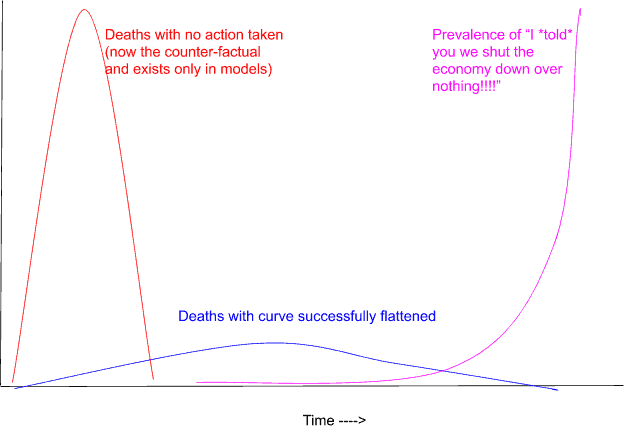
It still feels like a Pyrrhic victory.
So we’d like to open things back up, at least somewhat. But we don’t know how effective various partial measures are — if we ask people nicely to physically distance where possible, to wear masks in public, to wash their hands regularly (aside: people are disgusting: how many times before all this started were you in a public restroom and seen people not wash their hands? Too many to count?), to keep their social circles small and closed — will we be able to get that “R” factor to something close to 1? Like, really close to 1?
One problem is that we know the virus spreads very easily with no controls. We can see with a near-complete lockdown how the curve is bending. The incubation time is long, but even after 4 weeks of lockdown we still haven’t seen the damned curve flatline completely. It’s so much better than that exponential ramp to a mass burial pit in Queen’s Park circle, but it’s showing just how hard it is to really get the spread down.
And we still get to bad outcomes, just a little slower, if we have that “R” value much above 1. Exponential growth is a powerful thing, and it is not working in our favour here. So before we can throw open the doors of the economy, we would like to have a fair bit of certainty that we can slow the spread enough.
Ok, ok, enough prevaricating. I’m the re-opening Czar. I am the Grey, the one who stands between the candle and the star. I have to walk that tightrope between economic destruction and the risk of hundreds of thousands of lives lost (and survivors’ lungs scarred) and the associated chaos and pain. What do I do?
I don’t know.
There’s no certainty, no clear path, and it depends on whether a longer lockdown and increases to capacity puts a test-trace-contain option back on the table at some point. But I’d like to spark hope. We still have a bit of wiggle room on our healthcare capacity. So while we’re raising the line, I’d like to run the experiment to see what a partial re-opening could look like. Take a city, or a province, and ask them very nicely to imagine what they would do for the long-term — wear masks in public, try to keep distance, close the circle* of physical contacts as much as possible, work from home where possible, etc. Test often and sample the population well. And let that run for a week or two, and see what the resulting “R” factor or viral doubling time is. That will at least give us some data on how much we might be able to open, or if it might be possible to “pulse” the economy.
And after several weeks of lockdown, I’m optimistic that most Canadians are now prepared to take things seriously. While not everyone is wearing a mask to the grocery store, I’m not seeing people who are completely clueless about them any more (there were many in emerg when I was there with my Dad a few months ago wearing them around their chins, or not covering their nose, or removing them to cough). I haven’t had a need to use a public washroom since March, but hopefully people are finally washing their friggin hands properly.
* by this I mean all the people you see over the course of several weeks — that’s a potential chain of transmission. From you to your brother to your mom to her friend who comes over for tea to their nurse to… if we can keep that chain closed to a circle and compartmentalize society, that will help (again, not an epidemiologist, so I don’t know how much).
If we have the capacity to move to a test-trace-targeted-quarantine model, that would be good too. I’ll note for those interested that there are volunteer sign-ups.
At some point we will get people asking about the value of a human life. If the shutdown costs so many hundreds of billions, and it will only save so many hundreds of thousands, do we spend millions per life saved on other causes of death? Or the inconveniences — banning SUVs would save a not-insignificant number of pedestrian and road user lives and also save everyone money (except the auto industry) and benefit the environment but we’ve never had the will to do it.
So why, people (not me) will ask, do we go to such lengths for this virus and its death toll? And that’s a complicated and thorny question for the Czar who is not me. And whoever makes that call to prioritize the economy over hundreds of thousands of lives will quite likely be seen as our generation’s Hitler (esp. if it does indeed end up killing that many).
Kyle: I’m going to throw another random one at you here… Can we knock the costs of testing low enough, that we basically run society pretty darn close to normal – with just a ton of blood tests being done daily?
Answer:
That’s the South Korea model, basically. One challenge for us to follow is that they started from a lower starting point. We already have 35k confirmed cases as I write this. Perhaps 100k cases out there to find. And then how many contacts for each case to trace and test? (Maybe just 4-5 each with the isolation measures of the past few weeks, but it’s still a lot of testing ability). South Korea is doing something like 15k tests per day, with a much smaller caseload.
But I think that’s where we’ll go — it will just take time (months?) to get our testing capacity up and our starting caseload down (so first we have to get R below 1) to do it and let everyone else have a more-or-less normal life.
I’ve got a ton of ideas about how we could run schools in order to minimize interaction between students and that by September we could implement at least weekly blood testing for students if we had to. But I’ll save that rant for another day (and it appears that we are more than happy to let the European countries do the trial and error on schools before we give it a go).
Oh praise the almighty many-eyed Potato! Even in my napkin-doodling fantasies of opening the economy while keeping R to 1, I couldn’t fathom how we’d ever make schools work. And without schools and daycares operating, parents are really challenged to get back to work. (Remember when the Ontario teachers’ strikes were the biggest economic disruption we had to worry about? Fun times)
It’s an example though of some of the thorny issues. How do we keep kids from passing it around, and from classrooms and schools massively opening our closed circles of transmission? How do we move people in cities like Toronto without infecting everyone on the subway and bus?
I’ve been reading about how many airports believe they can operate at a pretty high level simply by doing a 10 minute blood test for anyone that walks in the door. That certainly seems like a dream scenario compared to what we’re dealing with now.
So could we see say… international flights, 70% full restaurants and shops, schools open, and the world more or less functioning as before – just with a ton of hand washing, a ton of masks, and a ton of surface cleaning? Is it possible to push the costs of tests down low enough that we could afford to do that level of testing, for another 9-12 months? Can we afford not to?
Kyle:
Ok – so getting to the economic side of all of this John. In order to get the most re-shares for this article I’m really hoping that you will either say:
1) The Great Depression 2 is upon us – we’re all doomed to live out Grapes of Wrath (but with Wifi).
2) This is a blip on the radar, now is the time to buy all of the stocks everywhere, because this is going to be the “V-shaped recovery”. All of this government money is going to fuel a gluttonous binge of spending, and we’re going to come back stronger than ever by the time Christmas rolls around!
Those two narratives seem to generate the most clicks, so it appears that’s where most people are falling.
Or would you give odds for something between those two statements? ;)
Answer: I am a crazy person.
I’m in the Depression (maybe not Great, but more severe and longer-lasting than a regular recession) camp.
Yet, I’m still fully invested.
Crazy, but as much as I’m pessimistic on the knock-on effects of this experiment in societal shut-down, I don’t have complete confidence in that guess. Forecasting is hard. And even forecasting the economic impact correctly may not be predictive of what stocks do. For example, mom and pop restaurants may have the worst year on record, but their bankruptcies may end up relieving the publicly traded chains of competition and letting them grow even more in the years to come.
Or more generally, the overall economic activity might drop, but the portion captured by publicly traded companies may increase to offset that. Or all the money printing might spike the price of stocks despite the underlying fundamentals. It’s too hard to say with any kind of certainty, so I’m sticking to my long-term plan of staying invested through the drop.
So, hearing that my prognostication is not actionable (nor are most others), you’d likely want to hear it anyway because it’s hopefully entertaining if not useful. (And might help you generate some clicks)
I doubt the V-shaped recovery will come. We were not in the best of shape before the virus came around. Over a decade since the GFC, and interest rates were still zero-bound in 2019. We didn’t have savings, we didn’t manage to turn the recovery into government surpluses and deleveraging, and there wasn’t much in the way of wage growth. We weren’t prepared for a shock like this, but we had terrible luck and got one anyway.
Even with massive government support, a lot of people are facing a reduction of income. Say we get a drug cocktail or vaccine or testing/tracing/containment capabilities that would let us go back to a fully open economy tomorrow: some measure of damage has already been done. Those with emergency funds will trim their spending for a while to refill them. Those without might do the same after getting slapped in the face with what not having one is like.
Some sectors might be down for a while — entertainment (large gatherings), oil, travel. People’s behaviours have changed after so long. Some habits may be broken (daily Starbucks trip?). In the blogosphere, “no-shop months” or spending bans were sometimes used to help people be more mindful of their spending, and to reset some habitual unconscious spending. Well, everyone has gone through that now. The Great Depression created a generation of frugal savers. This could too (I mean, 2008 didn’t, at least not for house-horny Canadians, but I think this shock might have hit home more).
And speaking of our unhealthy economy, the real estate sector had become an outsized part of the economy, particularly in Toronto. Could a trend toward urbanization and condo living be broken by this? My brother was joking back in March that he had to go to my parents’ cottage because if he had to spend the whole quarantine period in the few hundred square feet of their condo working from home with his fiancee that there wouldn’t be a wedding this summer. (In the end the wedding has been postponed to avoid having a large gathering).
How many other people, freed from the tyranny of having to move to a big city to solve the two-body problem by work-from-home arrangements, will be thinking that a place with a yard in any other small town might be highly preferable to spending one more minute in that shoebox? And how many ghost hotels will now flood the market if tourism dies? And if that leg of our one-legged stool of an economy goes and its attendant wealth effect, how big of a recession will that trigger?
It’s positive feedback cycles all the way down.
So I’m pretty bearish. I think there will be some aspect of a recession — some economic activity is simply gone, and that will echo out. But beyond that, such a big shared societal experience could be something entirely different.
The Great Reset.
It’s an opportunity — we can choose to think mindfully about what we want in our society. We can see how government benefits could work without up front bureaucracy and a pay-then-clawback-if-needed approach. We can choose what spending habits to break, what structures to rebuild, how we approach the notion of an office.
We could burn all the ridiculous open-concept offices to the ground.
We can see the lengths we are willing and able to go to save lives, and realize we can do it again and again and again. We can kill the toxic corporate cultures of companies that take engineering shortcuts that cost lives in the service of share prices. We can build redundancies and reserves and not leverage everything to the max in a plan that only tolerates perfection. We can trust people to understand exponential functions and complicated topics if we take the time to explain it, and we might be able to change things and make policies about more than just us-vs-them.
The virus has been, in a very dark humour sense, been called the “Boomer remover”. There has long been a hypothesis that there is a mystery generation between the Boomers and the Millennials, a “Generation X”, if you would. It will be this mystery generation’s burden and privilege to lead us out the other side of this mess. To rebuild the economy, and to do it mindfully, asking at each step whether the systems we are resuscitating ‘spark joy’.
I think it will hurt the whole time.
I only hope we are a generation of masochists.
“John Roberton predicts Great Depression – but Gen X will save the day!” Not a bad headline man!
Your nuanced analysis of the sad death/money calculus that lies before us is why I wanted to make you “Corona Czar” John. That all makes a lot of sense.
I also appreciate your notes of hope (amongst your predictions of a Depression/Reset).
As a fellow who has lived rurally his whole life, you’re preaching to the choir when it comes to anti-urban sentiment!
I think I’ll actually sign up to do some contact tracing as well – thanks for that link!
In the interest of not taking all of your time I’m going to focus my last couple of inquiries on just the economic and investing implications of all of this.
Although, if you have any awesomely hilarious nerd humour like graphs that chart the rise of Prevalence of “I told you we shut the economy down over nothing” people then please don’t let me stop you!
So you’re in the “bearish camp” when it comes to the overall economy. I guess we should make some effort here to differentiate between overall GDP macroeconomics predictions and the performance of the stock and bond markets. You and I talked briefly “off camera” that we both think the value of the Canadian and American indexes are valued substantially too high right now. I don’t know as much about other countries, but I look at what’s going on in the USA, and I think:
Ok – the “American Consumer” was constantly being held up as the one functioning engine of the world economy before this pandemic hit – that has to be gone now right? This unemployment level might decrease quickly, but there will likely be a huge number of people that simply can’t find work for months (years?) after this thing is done. Sure, we gave them $1,200 to prevent a complete meltdown, but the consuming habits that you mentioned are going to be drastically affected.
I think it’s important to note (full disclosure: I’m an Amazon addict) that when Amazon replaces brick-and-mortar retail, as well as a lot of small business, labour demand doesn’t just shift over. Amazon is much more efficient than the vast majority of these companies and will not need nearly as many workers as the traditional models. This hollowing out of the consumer class is going to have short- medium- and long-term effects that are over my head – but can’t be good for the stock markets. Companies should really be worth less than the 20%-off-the-peak that we’re currently seeing. Somewhere close to where we bottomed out seems a lot more realistic to my way of valuing companies.
Maybe let’s do it this way. Let me play Devil’s Advocate here. What would you say to people who state:
- These levels of monetary and fiscal stimulus are unheard of, and combined with the lobby might of big business in the USA, big companies will come out of this thing in 12 months having gobbled up market share, and will be more profitable than ever!
- There are just too many people that need to see the stock market go up for it to fail. The world’s Federal Banks, and their politicians will do whatever they need to when it comes to borrowing to stoke this fire.
- Formerly “decent” (for there are no “good” predictors when it comes to accuracy of investing predictions) such as the CAPE ratio are almost irrelevant now, as lower taxes, and unprecedented moving of debt from corporate balance sheets have made company ownership intrinsically more valuable. Paying more for the same earnings of 30 years ago is quite logical.
- The government will never raise interest rates again – there is too much political influence that will never allow them to do so. We have no evidence that inflation is still a thing. Consequently, with “money being so cheap”, it follows that companies with hard assets are worth more than they have been in the past.
- So if earnings come back even close to where they were, and we can all agree that companies should be worth a much higher multiple of their earnings than they were in the past, then why aren’t companies properly valued right now and why can’t we see a “V recovery”?
Finally – and I’ll get you out of here on this one John – you mentioned that you were still fully invested in your normal long-term indexed, passive investing portfolio (which again – folks can learn all about in your book or course).
Essentially, what you’re saying is that despite your “take” – and your pretty darn solid understanding of markets – you’re actually much more comfortable betting on the fact that the world’s biggest companies will just continue to make money in the medium- and long-term no matter what the overall economy does?
I’m fairly certain that I agree with your take btw!
Well, I can be bearish, and I can say that I think equities are overvalued, but that’s just like, my opinion, man. For the purposes of debating over a cup of tea, I’ll take that position and try to make it entertaining. But forecasting is hard. Those points you raised are good ones — I can argue one way or the other but the thing to keep in mind is that at the end of the day I have low confidence in my ability to predict.
I might not be optimistic on what markets might return in the near term, but I’m even less optimistic and confident in my ability to accurately time (or value) the market, and get it right in both directions. I am more confident that in the very long term, a buy-and-hold approach works for investing, so I’ll stick with that.
My other reasoning for staying fully invested is simple:
What other asset class do I want my money in right now?
Exactly!
As for the specific points above that I haven’t addressed yet:
- These levels of monetary and fiscal stimulus are unheard of, and combined with the lobby might of big business in the USA, big companies will come out of this thing in 12 months having gobbled up market share, and will be more profitable than ever!
Possibly. The stimulus might also just be back-filling a massive hole in the economy, and we’ll still come out flat or slightly worse — or the stimulus might be pushing on a string.
- There are just too many people that need to see the stock market go up for it to fail. The world’s Federal Banks, and their politicians will do whatever they need to when it comes to borrowing to stoke this fire.
People needing the market to go up has not historically been a good source of support. I’ve made the same argument for Canadian housing (over the years a surprising number of bulls have said that too many people need the market to stay up, so governments, etc. will do everything to keep them propped up — though the price action has been on their side) and to me this argument says the risk is even greater then because if a correction does come that can’t be stopped, there are a lot of weak players who may be forced to sell!
- Formerly “decent” (for there are no “good” predictors when it comes to accuracy of investing predictions) such as the CAPE ratio are almost irrelevant now, as lower taxes, and unprecedented moving of debt from corporate balance sheets have made company ownership intrinsically more valuable. Paying more for the same earnings of 30 years ago is quite logical.
- The government will never raise interest rates again – there is too much political influence that will never allow them to do so. We have no evidence that inflation is still a thing. Consequently, with “money being so cheap”, it follows that companies with hard assets are worth more than they have been in the past.
These two kind of go together. I can say that I used to scoff when people would say that rates wouldn’t go up again, and I was wrong on that, from like 2012 or so to now. So sure, maybe rates won’t go up again, which then suggests that P/E ratios should be compressed. Not sure about the last point on hard assets — aren’t hard assets easily replicated and not valued in a world with no inflation and cheap capital?
- So if earnings come back even close to where they were, and we can all agree that companies should be worth a much higher multiple of their earnings than they were in the past, then why aren’t companies properly valued right now and why can’t we see a “V recovery”?
The past being 2019? When rates were already so low? While I can see the argument for why this time it may be different and P/Es of the past may not be comparable to those of today, I don’t see why that would go another level higher than they were.
And anyway, I’m skeptical on a V-shaped recovery in the economy (though the economy doesn’t translate perfectly to equities).
If this doesn’t pop the “I-need-a-house-at-any-cost-so-that-I-can-be-an-adult” bubble that Canadians have subscribed to for far too long… then I don’t know what will. I just know that I want nothing to do with real estate at the moment.
The idea of speculating on a shiny metal or a cryptocurrency has always seemed insane to me. Bonds, GICS, and high-interest savings accounts are paying out next to nothing. Cash has certainly not been “king” the last couple of weeks… I think routinely buying solid indexes through products like Canada’s all-in-one ETFs or looking at robo advisors such as Wealthsimple are still the best investment paths for the vast majority of Canadians.
That said, for more “sophisticated” long-term investors, do you have any thoughts on semi-exotic ways to boost their portfolio – such as covered calls? If a person can make an extra 2%+ on their portfolio by selling a covered call on a 3,100 valuation of the S&P 500 index – is that a solid low-risk move? Alternatively, you mentioned your recent success with a put option in your article, (I’m calling this article “The Little Short” – I heard that Gerard Butler signed on to play Dr. John Robertson in the movie adaptation) given your macro-economic thoughts, and your long-term passive portfolio, are you hedging at all with some shorting action these days?
Note to readers: If that last paragraph didn’t make any sense to you – don’t worry, you definitely don’t have to do any of that jazz to be a successful investor. It’s basically just me trying to use Wall Street Lingo to prove how legit I am.
For more sophisticated investors, they will know the evidence and stick with a broadly diversified, low-cost, buy-and-hold approach.
That’s a great misconception to highlight, that the more complicated portfolio tools that are harder to access are seen as better. More “sophisticated” might be right in the sense that sophisticated can mean complex, but people will think that means better and that’s not necessarily so. The Big Short, the Little Short, whatever, provided some ways to potentially make more money off a prediction than buy-and-hold, but that came with a lot of risk, too, and it was a lot harder to say whether the bets really had a high expected return going in or how reliable that return would have been.
So this isn’t for more sophisticated investors, it’s for degenerate gamblers. And hey, I do gamble sometimes — I just try not to tell myself that I’m being a sophisticated investor when I do it. That’s part of why instead of just selling shares I owned, I bought a put instead, because I could use some mental accounting to classify that as a gambling expense and not a part of my long-term portfolio.
Anyway, anyone who knows how to implement a covered call strategy doesn’t need to hear my thoughts on it.
And to reiterate the point, predictions are hard. They’re fun to make, we want to talk about and debate what the future might hold (for lots of good reasons), but actually changing your investment strategy based on them is usually a bad move. That’s what made the Big Short (and “the Little Short”) so remarkable — there was a mis-priced risk that some people capitalized on. Very few people saw the trouble just ahead (and in the Big Short, many didn’t believe such trouble was within the range of possibility), and insurance was fairly cheap. In hindsight, I wish I had made it a bigger bet, but hindsight is 20/20.
Which brings me around to say that even though I might have a particular view, it’s not strong enough to drive me to veer off my plan. We’re just talking here, and there’s a big difference between actionable information and business entertainment. Moreover, it’s not a fringe view anymore — all the market chaos speaks to the number of other people with worries about future profitability, etc. I might regret not doing anything at this point, especially if the market crashes after I wrote out all my reasons for being bearish, but it’s very hard to say that I have any kind of edge, or that I’m seeing something other people aren’t seeing right now. When we don’t have an edge, then buying-and-holding-and-diversifying is usually a good default. And when we think we do have an edge, it’s usually wise to re-consider anyway because we’re probably wrong.
Thanks for agreeing to do this John – really appreciate your time and expertise!
<Janet voice>Not an expert.</Janet>
Thanks for letting me rant to you, and for your patience in my slow responses, and for somehow thinking all this should be published!
Stay healthy!
I've Completed My Million Dollar Journey. Let Me Guide You Through Yours!
Sign up below to get a copy of our free eBook: Can I Retire Yet?

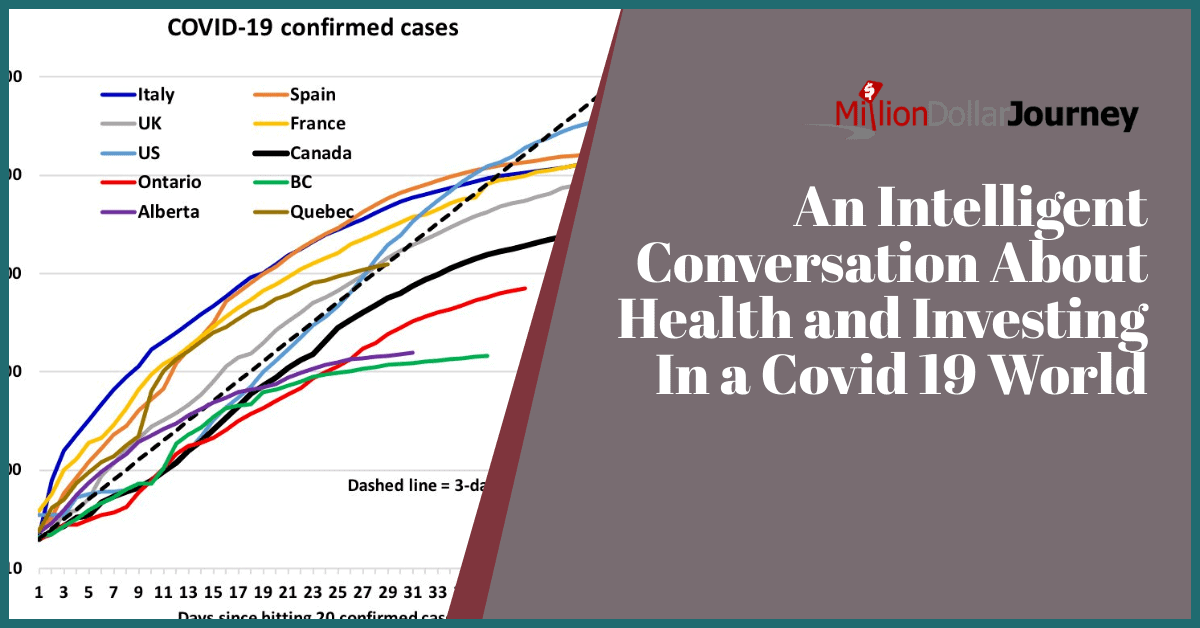
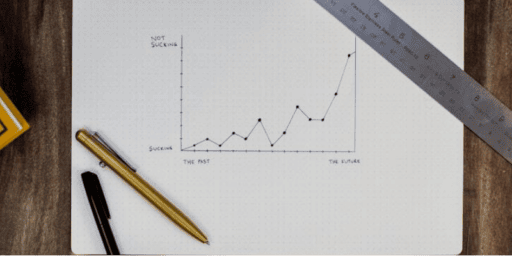
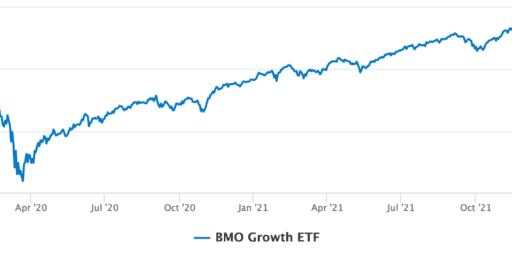
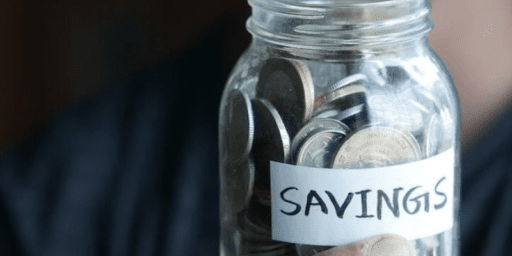


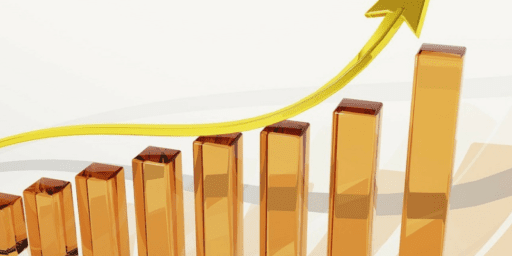
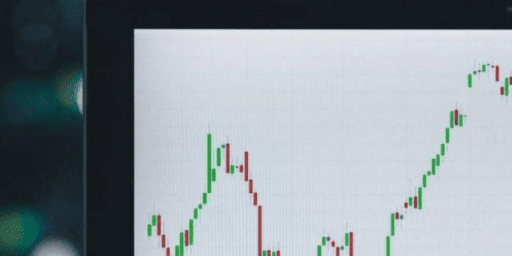
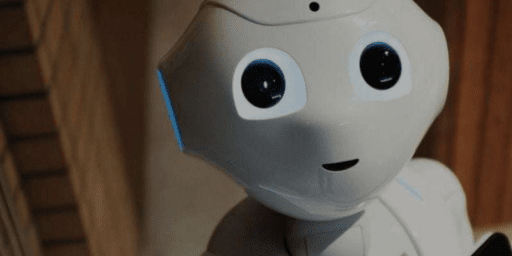

Great read, thanks guys!
Fantastic, thanks Kyle and John!
Steve